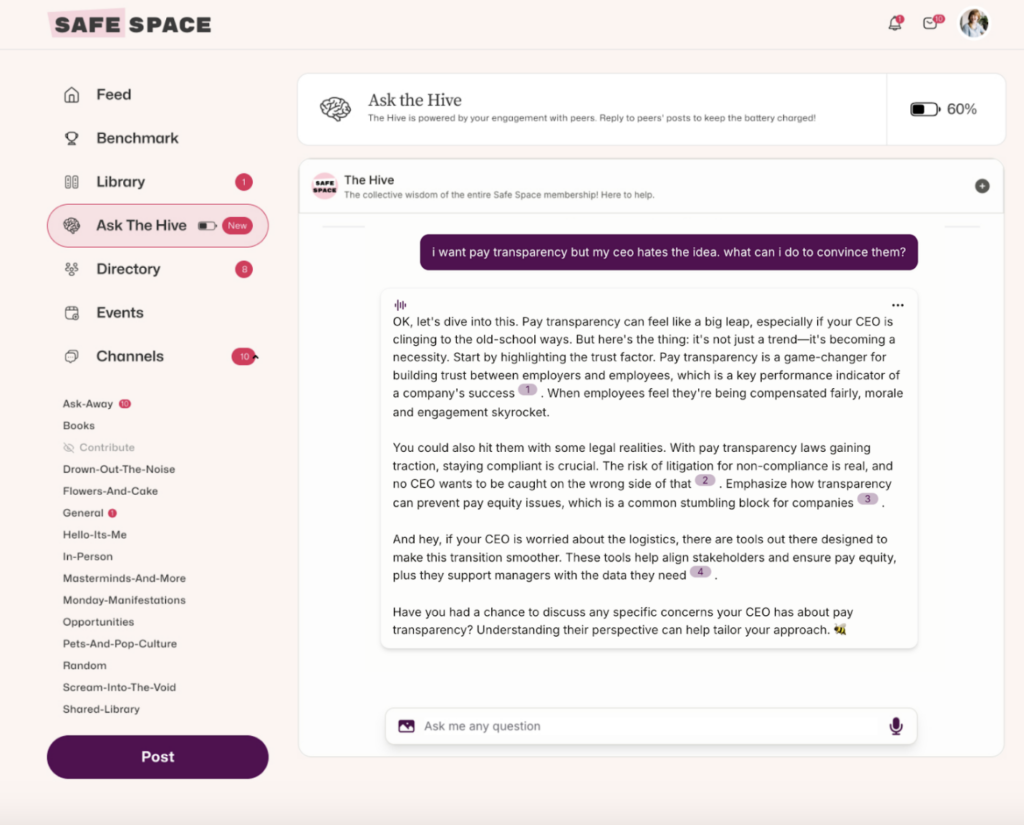
I manage a team of part-time, fully remote brand ambassadors across different time zones. Many have been on the team for years and, while they meet their monthly minimums, seem to have lost their spark. Any ideas for re-invigorating their passion for the brand and our mission?
Context: 5000+ employee tech company in consumer marketing sector
Rebecca Dobrzynski, Senior HR Business Partner:
I know you are looking for actionable ideas to re-engage this group, but I really believe that in order to find the right solutions, you have to understand the root of the problem. And you’ll likely get better outcomes if you involve the employees in coming up with a solution!
So, what to do?
- What do you know about their overall sentiment, and from what sources? Can you do some focus groups with employees you know were previously highly engaged to get them talking about what’s different and what they’d like to see going forward? Do you have recent engagement survey data you can comb through, or can you implement a survey specific to this topic? What does the team say is going on, in their own words? This is the gold standard info to have before you try to implement anything on your end.
- Who on the team is still highly engaged? Can you tap them for ideas about what keeps them motivated? Do they have an ear to the ground about why others have “lost their spark”?
- Do any of your management peers have similar issues on their teams? Can you brainstorm with them to see what’s worked on other teams, what ideas they have but haven’t tried yet, etc.?
Without more specific information, there are still a couple avenues I think you could explore to re-engage folks:
- Re: “passion for the brand and our mission”… this is one of the many reasons that customer/user-storytelling is so crucial! How much is this team getting together to talk to each other or hear from others about the people out in the world that are engaging with your brand? Do they have real-life, frequent examples of the impact of the work they are doing? Are there forums to share cool wins and learnings from any specific projects or events they are going to? If no, implement this asap! If yes, see if you can put a fresh spin on some of these stories or find other ways for your team to engage with them.
- Re: relatively long tenure… when I see a dip in engagement among highly tenured employees, I usually suspect that there is some dissatisfaction with pay, learning/growth opportunities, or both. What do you know about those areas for your team specifically, and is there a way for you to advocate for more? (Within reason and with justification, of course!)
I also can’t help playing devil’s advocate for a moment: are you sure this is actually a problem? You mention that these employees are still hitting their minimum, so I wonder if you can articulate the business impact of this lesser engagement. If there are real reasons to see more “passion” from your employees (and since they are brand ambassadors, there probably are), then please do continue with trying to find a solution. But if they are just not as peppy or proactive as they used to be, but they are fulfilling the needs of their role, then… well, it’s been a really rough few years for most people. It might be okay that they aren’t going above and beyond, and you’d be a very human leader to acknowledge that.
Dennisse Bray, Senior HR Generalist:
Not to oversimplify, but what about simply doing a check in?
If you have 1:1s, have the team leaders use that time to discuss how they’re feeling.
Sometimes a lack of engagement goes beyond just the product and mission. Certain individuals may be dealing with things outside of work.
We should never pry into someone’s private life, of course. That’s not the intent.
It’s surprising how far a simple question like “How are you doing?” can go! ✨
And if you have employers willing to share ideas, continue to encourage that behavior. I’ve seen lots of folks appear less engaged at work simply because their ideas have been turned down in the past, and they’re afraid to share ideas again.
Separately, I’d be curious to know why there’s an evident lack of engagement if they’re meeting their minimums? Is it that they are not exceeding their goals? Is it in the way they approach their work?
Knowing how engagement is actually measured can help against the mere perception of disengagement.
JOIN 150K+ HR LEADERS
Get insights, learnings, and advice on how to build companies and cultures that people actually love.
No spam. Unsubscribe any time.
Follow your ABCs: Always be curious. ♥️

I have the support of my CEO, but I’m often left out of strategic meetings/discussions that would help me to understand what they’re looking for and where to place my focus. I’m often told what decisions are being made after the fact rather than being able to participate in the decision-making. How do I change this and make sure that I’m included in strategic business discussions?
Context: I’m a part of a very small org that didn’t really have any sort of official HR function until last year. I work remotely from a different state than the majority of our Leadership team. It doesn’t seem like they’re not including me on purpose, but more that I’m an afterthought.
Rachel Ackerman, Director, People Operations @ Barstool Sports:
That is such a great question and difficult position to be in. Have you taken the time to sit with your CEO and discuss with them the importance of having a seat at these discussions so you’re in the loop from the beginning? Bring a list of examples where you can display that being in the conversation from the onset would have saved time, ensured accuracy in data, allowed you to ask questions of the larger group to gain clarity.
I tend to find going back to my boss or higher ups with data supporting why it’s important to have that seat at the table allows me to provide a better experience for all: leadership, the org, and myself. In the long run, you’ll likely find you’re saving time and therefore $$$ by being in the discussions on day 1.
Gina Esposito, Founder & Chief Practitioner @ Holisticallyhr™:
Feeling left out of strategic discussions can be frustrating, especially when you (really do) have the support of your CEO/Leadership Team.
I’ve proactively deployed some of the below solutions (not necessarily listed in order of importance) and have found them to be super helpful.
Initiate Conversations: Schedule regular check-ins with your CEO or leadership team to express your interest in being included in strategic discussions. At the very least, be sure that you are included in and/or invited to leadership team meetings. If it really feels like an uphill battle to be included, frame it as a desire to align your work with the organization’s goals.
Clarify Your Role: Make sure your role and contributions are clearly defined within the organization. If your position is perceived as more operational, communicate AND demonstrate on a daily basis that your capability and desire to engage in strategy matters. One example of this, can be using metrics in a leadership meeting on a particular topic that supports, enhances and informs. The business loves numbers.
Ask for Context: When decisions are communicated to you after the fact, if possible, try to understand the reasoning behind them. Ask for insights on the discussions that led to those decisions. This shows your interest and can help you position for future involvement. If you feel comfortable in your relationship with your leader, you can also suggest alternative strategies outside of what was decided (carefully articulating so as not to insult the final decision unless it’s something you are comfortable with). This will further demonstrate you have the capacity to be included in the upfront thought process and strategic decision making.
Build Relationships: Since you’re remote, take the time to connect with colleagues and leaders. Building rapport can lead to more inclusion in conversations, as people are more likely to involve (and remember) those they know. Video meetings may be annoying, however face to face on the screen is the next best thing to IRL meetings.
Be Consistent but Patient: Change takes time, especially in a small organization. Continue to express your interest in strategic discussions and show your commitment to the organization’s success. Repetition in the actions you take or the things you (your team does) is also very helpful.


